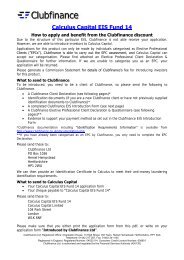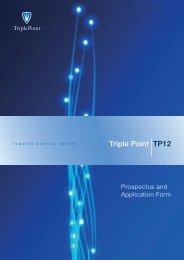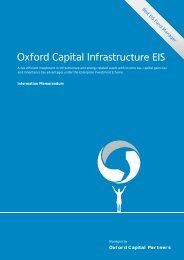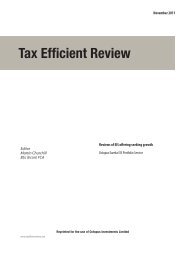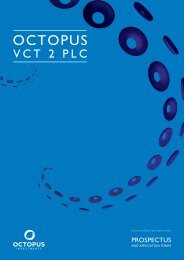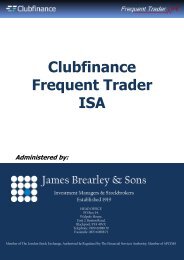Jenson Seed EIS Fund - Clubfinance
Jenson Seed EIS Fund - Clubfinance
Jenson Seed EIS Fund - Clubfinance
- No tags were found...
You also want an ePaper? Increase the reach of your titles
YUMPU automatically turns print PDFs into web optimized ePapers that Google loves.
44 <strong>Jenson</strong> <strong>Seed</strong> <strong>EIS</strong> <strong>Fund</strong>Tax Reliefs 45Tax Incentive 4: Inheritance Tax ReliefAlthough not a S<strong>EIS</strong> tax relief as such, a S<strong>EIS</strong>Qualifying Investment will qualify for 100 per centrelief from inheritance tax (“IHT”) under currentlegislation, provided that the Investment hasbeen held for at least two years, it is still held attime of death and remains unlisted.ExampleMrs Smith, a widow, is 68 years old and has anannual income of £100,000 and a total estateworth £1 million. Under current legislation,her taxable estate would be £675,000 (i.e. £1million less the tax-free allowance of £325,000- the nil rate band in the tax year ending 5April 2013). This would result in an IHT liability of£270,000 (i.e. 40 per cent of £675,000) and anestate, net of IHT, worth £730,000.In order to reduce her potential IHT liability,Mrs Smith decides to invest £100,000 inthe <strong>Fund</strong> which in turn is invested in S<strong>EIS</strong>Qualifying Investments in tax year 2012/13.In addition to any tax-free capital growthon her original S<strong>EIS</strong> Qualifying Investments of£100,000, Mrs Smith will also receive £50,000of income tax relief under the S<strong>EIS</strong>.Furthermore, assuming she survives fortwo years, and still holds the Investmentsas at the date of her death her estate willsave £70,000 upon her death (assumingno change in the value of her £100,000investment). Her IHT liability is reduced to£230,000 (£270,000 previously) and, takinginto account her S<strong>EIS</strong> Relief, her estate is nowworth £800,000 (£730,000 previously) in otherwords her net estate is £70,000 better off.The end value of Mrs Smith’s estate willtherefore be:Estate not invested in <strong>Jenson</strong> <strong>Seed</strong><strong>EIS</strong> <strong>Fund</strong>Less IHT(at 40 per cent of £575,000, i.e.£900,000 less £325,000 nil rate band)£900,000(£230,000)Net uninvested £670,000Income tax relief £50,000Less IHT(on the increase in the estate)(£20,000)This example assumes there is no change inthe value of her £100,000 investment in the<strong>Jenson</strong> <strong>Seed</strong> <strong>EIS</strong> <strong>Fund</strong>. Were the value ofher Investment to increase to £130,000, MrsSmith’s estate would be £100,000 better offthan had she not invested in <strong>Jenson</strong> <strong>Seed</strong><strong>EIS</strong> <strong>Fund</strong>, and the whole of the increasedvalue would be free of IHT.£30,000Return of investment in the <strong>Fund</strong> £100,000Post tax value of estate £800,000






